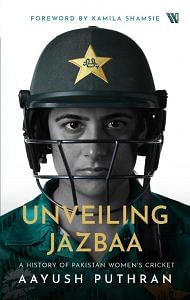The summer of 2004 was as friendly a time for an Indian to be in Pakistan as it has ever been since the two countries announced their respective independence in 1947. Atal Bihari Vajpayee, the Indian prime minister, had sent across the Sourav Ganguly-led Indian men’s cricket team for their first Test tour to Pakistan in 15 years as political doves with a solitary message: “Khel bhi jeetiye, dil bhi jeetiye” (‘Win games as well as hearts’).
The tour went ahead despite bombings and threats by fringe forces in the country, and cricket paved the way to improve relations, which had gone sour following the 1999 Kargil War and the 2001 attack on the Indian parliament. With the media also overdosing on the rare opportunity to fuel peace messaging between the two countries, the high-profile cricket and political movement overshadowed one of the finest moments in Pakistan
women’s cricket. Shaiza Khan’s PWCCA was set to host the West Indies for a fully-fledged international series, which consisted of seven one-dayers and Pakistan’s first-ever home Test match, all to be played in Karachi. It was a late call on the West Indian team, who had originally been scheduled to fly back following their tour to India.
Relations between Shaiza and the PCB had nosedived by then, and Ramiz Raja, the former Pakistan men’s captain, who had been appointed as the chief executive of the PCB, attempted to sabotage the series. Ramiz wrote a letter to his West Indian counterpart, Roger Brathwaite, requesting that he cancel his team’s tour of Pakistan. In a press release on 11 February 2004 – just a month before the scheduled series – the PWCCA stated, “It is surprising for the executive committee of PWCCA to learn of this move of PCB’s CEO as Ramiz had personally approached the PWCCA at the PCB seminar held in Karachi last month and had extended his full support, saying the grounds are yours and we will definitely give them to you for the said series. “It was at Ramiz’s suggestion that PWCCA wrote a letter of request to the PCB for the use of the National Stadium to which the PCB, instead of replying to the PWCCA, wrote to the West Indies to cancel the tour.’
The Lahore-educated Ramiz doesn’t deny the claims. ‘You have to understand that in those days women’s cricket was an emerging format run by different independent bodies,’ he states in defence. ‘The PCB wanted to streamline women’s cricket affairs and bring women’s cricket under its wing to give it an official, credible status. The Shaiza Khan group, a family of sisters interested in the game, with money and contacts, were controlling the women’s game and were making independent arbitrary decisions, introducing themselves as a recognised body to the world, inviting teams and also, with it, inviting criticism of frustrated cricketers from other areas and regions who were being ignored in the selection and administrative process. The PCB had to therefore step in.’
Also read: When Arun Jaitley, Priyanka Gandhi and I cheered for Team India in a Karachi stadium
Irrespective of Ramiz’s reasons, the extraordinary effort to halt the cricket organised by the PWCCA didn’t stand to directly benefit anyone – neither the PCB nor any group of women anywhere. But there was a larger power play in the equation. The PCB wanted to transfer the power of running the affairs of women’s cricket out of Shaiza’s hands. Shaiza’s primary position of strength was the PWCCA’s membership of the IWCC, which was also working to assimilate with the International Cricket Council (ICC), the international governing body of men’s cricket. A good performance by her team, as achieved against the Netherlands, could severely derail the PCB’s efforts.
Despite Ramiz’s attempt to halt the series, the West Indies turned up and all the matches took place as scheduled. Ramiz was possibly only following the orders of Shahryar Khan, the suave former Pakistani diplomat who had been elected as chair of the board in December 2003. Hailing from the royal family of Bhopal, and first cousin of Mansoor Ali Khan Pataudi, Shahryar didn’t think too highly of Shaiza’s cricket team and dubbed the contest a ‘Sindh vs West Indies’ affair. He had his reasons for the assessment; at least six players in the 11 for the first Test were from Sindh province.
However, Mehmood Rashid, a former domestic cricketer, was optimistic that the team – despite its failings in international cricket – was a promising project. He had taken over as coach in 2003, during the IWCC Trophy campaign, when he had travelled with the team to the Netherlands. It wasn’t a full-time professional contract for Rashid, who was an employee of United Bank Limited. ‘I had told Shaiza that I wouldn’t be able to give a lot of time to the team,’ he explains. ‘Yet she agreed and said that she would ask the girls to come for training at a time that was convenient for me. I said, “Early morning, 5.00 a.m.,” and she agreed. She even sent a car to pick me up and take me to the ground. It was only later that I realised that she had agreed to my demands only to check if I was really serious about it.’
Mehmood had little clue about the West Indies team. He had never seen them play. But before Shaiza could hand over tapes of their matches, she sent him the scorecards of the two teams. It was in these that he discovered the most obvious quick fix to Pakistan’s problems. ‘Our bowlers were bowling a lot of wide deliveries,’ he notes. ‘That was making a massive difference. Otherwise, there wasn’t much separating the two teams.’ In 33 ODI games up to that point, Pakistan had delivered 515 wides: 40 in three matches in New Zealand and Australia; 111 in the five matches at the 1997 World Cup; 16 in the three matches of the 2000 Sri Lanka tour; 40 in the four-match series in Ireland; 165 in the seven-match home series against the Netherlands; 63 in five matches in the 2002 Sri Lanka tour; and 86 in the IWCC Trophy. The average of more than 15 wides per game was high even by normal standards. For Pakistan it assumed even greater significance as their opposition were often chasing low totals.
With Uzma Gondal leaving the PWCCA set-up, another of Mehmood’s key responsibilities was to find and train a player for wicketkeeping duties. The early experiment with Mariam Butt failed before he cast his eyes on 21-year-old Batool Fatima. A tall and lanky batter, she – along with left-arm spinner Khursheed Jabeen – was one of Shaiza’s most promising finds from the trials at the Sir Syed Government Girls College in Karachi, ahead of the 2001 home series against the Netherlands. Even though she was slightly tall for a wicketkeeper, her natural hand movement in collecting the ball impressed Mehmood. ‘Initially, she had a tendency to get up too early; it was difficult to make her stay low,’ the coach noted in his assessment. ‘So, I would keep my hand above her head and tell her not to touch it while the ball was in play. By the fourth day, she was extremely comfortable with her keeping.’
 This excerpt from Unveiling Jazbaa by Aayush Puthran has been published with permission from Westland Books.
This excerpt from Unveiling Jazbaa by Aayush Puthran has been published with permission from Westland Books.



